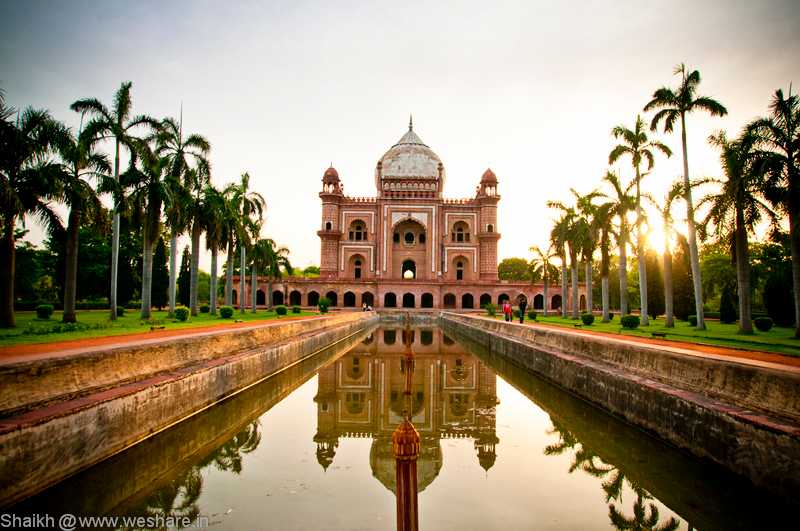
History of Safdarjung Tomb
Muhammad Muqim in Khurasan was born as a Persian native in 1708 AD. In 1722, he relocated to India and soon after, in 1739, he became the Subedar Nawab of Oudh, viceroy to the Mughal Emperor Muhammad Shah. With the death of Muhammad Shah, his son Muhammad Shah Ahmad Shah ascended the throne in 1748, and Muhammad Muqim was promoted to the post of the Chief Minister under the title of Wazir ul-Mamalk-i-Hindustan. He was also bestowed with the title of ?Safdarjung?. As the new king was immersed in wealth and women, Safdarjung took charge of the duties, and the king merely became a puppet in the hands of the Chief Minister.
Gradually Safdarjung started over utilising his authority and exploiting his privileges. Consequently, he was dismissed from his post ensuing some court politics and was exiled in 1753. After his death in 1754, his son Shuja- ud- Daula pleaded with the king and on his consent constructed this mausoleum in the memory of his father which was called Safdarjung Tomb or ?Safdarjung ka Maqbara?.
Architecture of Safdarjung Tomb
Safdarjung Tomb was one of the last colossal tombs of the Mughal architecture inspired by the very famous Humayun?s Tomb. The design had four key features- the char bagh style- the mausoleum in-between surrounded by four gardens, the nine-fold floor, five facade design and a huge rostrum with a secret passageway. The front of the monument has intricate ornamentation and has been painted in florid purple shades. The inscription at the entrance is written in Urdu which can be translated to ?When the hero of plain bravery departs from the transitory, may he become a resident of God?s paradise.?
The main mausoleum has high arched walls with intricate carvings, the cenotaph is reposed on the central chamber which is square in shape, and the dome rests on top of the terrace. The underground chamber beneath the cenotaph has the graves of Safdarjung and his wife. Built entirely with red and buff stones, the interiors of the maqbara are covered in rococo plaster work. Four polygonal towers decorated in marble and possessing huge arches occupy the corners of the tomb from outside. The rear side of the monument houses a library and several rooms. To its right, is built a mosque.
The facade though following the conventional style of Mughal architecture and built closely on the lines of Taj Mahal, clearly lack the precision of a professional architect. The structure appears unbalanced due to accentuated prominence of the vertical axis, the dome is more elongated, and the four minarets are a part of the main monument, unlike the Taj Mahal where the minarets are detached. It has also been noticed that the marble used in the construction is not completely ?white? and the quality of materials used was rather ?poor?. All in all, most studies conclude that the fort is a significant example of the declining Mughal kingdom.
Gardens at Safdarjung Tomb
The gardens surrounding the mausoleum are built in the typical Mughal charbagh style, based on the designs of Humayun?s Tomb. Fenced by a 280 metres high wall, the gardens are further divided into four squares with neat little pathways and sparkling water tanks. One passage leads to the main gate while the others lead to the pavilions. The main mausoleum stands on a dais which is 50 metres in height. Four pavilions and octagonal chhatris or towers with arches built in rubble stone masonry, complete the structure of the monument.
The pavilions in the Western, Southern and Northern directions are called Jangli Mahal, Badshah Pasand and Moti Mahal respectively. These pavilions were originally the residence of the Nawab?s family. In addition to this, the complex also houses several tiny apartments, a mosque and a courtyard.
Best time to visit Safdarjung Tomb
Winters, early Spring or Late Autumn, is the ideal time to visit this place due to the infamous Delhi heat. The summers can get scorching and sultry, and your visit can get unbearable and really uncomfortable.
How to Reach Safdarjung Tomb
Delhi is a state well connected through metro and state-run buses. The nearest metro station to Safdarjung Tomb is Jor Bagh Metro, situated on the yellow line. The mausoleum is just about 300 metres from the metro; you can either choose to walk or hire a local or a battery run rickshaw. You can also book a taxi cab for a more comfortable journey. Alternatively, you can travel in one of the buses which will be relatively economical.
Top Tourist Places in New Delhi
Hauz Khas Village
Red Fort
Qutub Minar
India Gate
National Zoological Park
Chandni Chowk
All Tourist Places in New Delhi
Tips
1. It is advisable to carry a bottle of water to stay hydrated.2. Carry some cash if you wish to buy knick-knacks and local souvenirs from stray stalls outside the mausoleum.3. Try visiting in the early hours of the morning to avoid the tourist rush.
Comments on Safdarjung Tomb
Post Your Comment